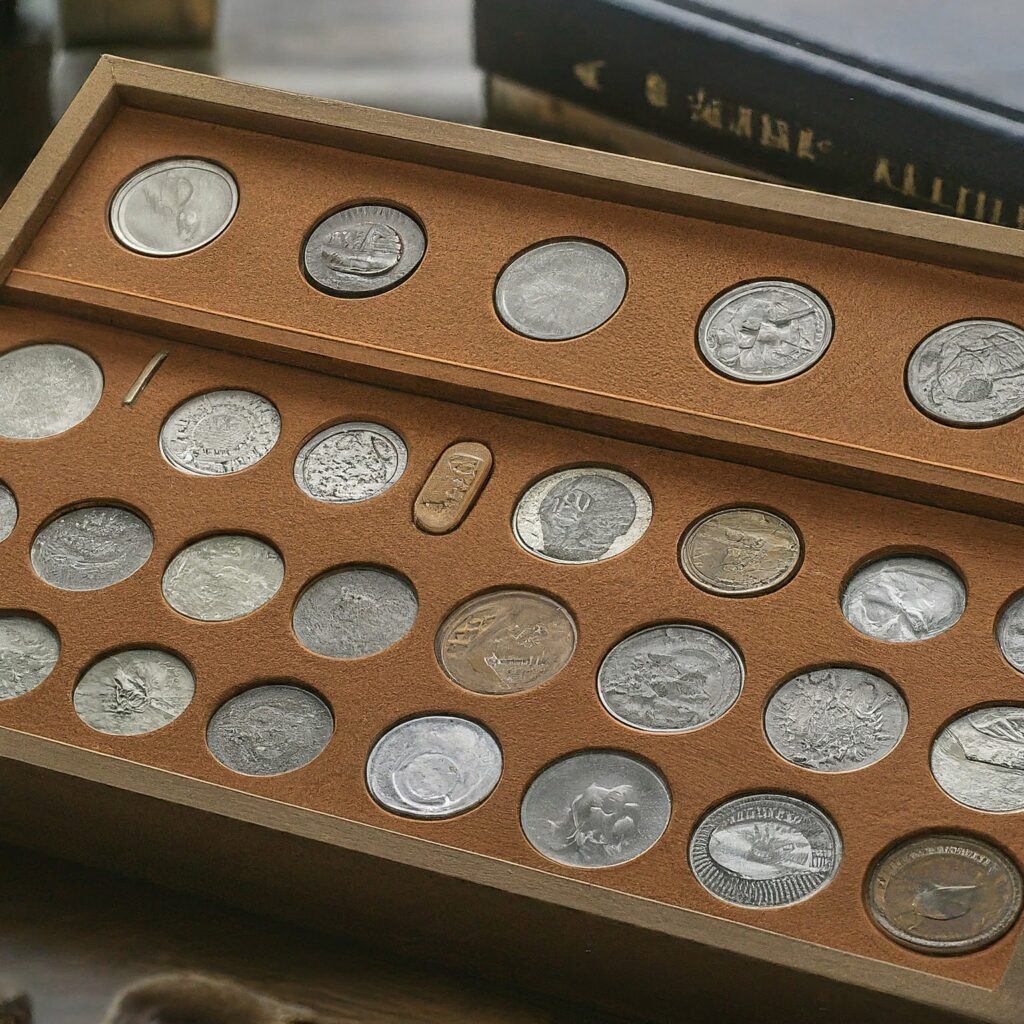Last updated on October 17th, 2024 at 10:22 am
Have you ever looked at your prized collection of vintage hockey cards, rare coins, or limited edition action figures and thought, “I wonder if these are worth something?”
Well, my friend, you’re in for a treat.
The world of selling collectibles online in Canada is not just a hobby – it’s a thriving market waiting for passionate collectors like you to dive in.
As someone who’s turned their basement full of “junk” into a six-figure business, I’m here to tell you that selling collectibles online in Canada is not only possible but potentially lucrative.
But let’s get one thing straight: this isn’t about getting rich quick.
It’s about understanding the value of what you have, connecting with the right buyers, and building a reputation in the collectibles community.
In this guide, I’m going to walk you through everything you need to know to start selling collectibles online in Canada.
From the essential tools you’ll need to the step-by-step process of listing and shipping your items, we’ll cover it all.
So, whether you’re looking to clear out some space, fund your next big purchase, or turn your passion into a full-time gig, buckle up.
We’re about to embark on a journey that could change the way you look at those dusty old treasures forever.
What You’ll Need to Sell Collectibles Online in Canada

Before we talk about selling collectibles online in Canada, let’s talk about what you’ll need to get started.
Think of this as your collectibles selling toolkit:
- A reliable computer or smartphone: This is your command center. You’ll use it for research, listing items, and communicating with buyers.
- High-quality camera: Clear, detailed photos are crucial. Your smartphone camera might suffice, but consider investing in a good digital camera for even better results.
- Good lighting setup: Natural light is great, but a simple light box or portable studio lights can make your items pop.
- Shipping supplies: Stock up on bubble wrap, packing peanuts, boxes of various sizes, and sturdy envelopes.
- Postage scale: Accurate weight measurements are essential for calculating shipping costs.
- Printer: You’ll need this for printing shipping labels and invoices.
Now, let’s talk about some legal considerations specific to selling collectibles online in Canada:
- Business registration: If you’re planning to sell regularly, consider registering as a business. This can be done online through your provincial government website.
- Tax implications: Familiarize yourself with GST/HST rules. You may need to register for a GST/HST number if your annual revenue exceeds $30,000.
- Import/Export regulations: If you plan to sell internationally, research Canada Border Services Agency (CBSA) regulations.
Top tools I recommend for selling collectibles online in Canada:
- Worthpoint: An invaluable resource for pricing collectibles based on actual sold prices.
- Canada Post Small Business Solutions: Offers discounted shipping rates and easy label printing.
- Shopify: If you’re serious about building your own online store, Shopify is user-friendly and has great features for Canadian sellers.
Remember, selling collectibles online in Canada isn’t just about having cool stuff to sell.
It’s about being prepared, organized, and professional.
These tools and considerations will set you up for success from the start.
Step-by-Step Instructions to Sell Collectibles Online in Canada
1. Research and Valuation
The first step in selling collectibles online in Canada is knowing what you have and what it’s worth.
- Identify your item: Research the specifics of your collectible. Look for maker’s marks, serial numbers, or distinguishing features.
- Check sold prices: Use platforms like eBay’s sold listings or Worthpoint to see what similar items have actually sold for.
- Consider condition: Be honest about the condition of your item. Even small flaws can significantly impact value.
Tip: Join online communities or forums related to your specific collectibles. These can be goldmines of information and potential buyers.
Warning: Beware of price guides that don’t reflect actual market values. Always base your pricing on recent, verified sales.
2. Cleaning and Preparation
Presentation is key when selling collectibles online in Canada.
- Clean carefully: Use appropriate cleaning methods for your specific collectible. Some items may lose value if cleaned incorrectly.
- Repair or restore?: Consider whether repairing or restoring an item will increase its value or potentially decrease it.
- Gather documentation: If you have certificates of authenticity, original packaging, or provenance documents, keep them with the item.
Tip: Always photograph the item before cleaning or repairing, in case of any accidental damage.
Warning: Never attempt to repair valuable or delicate items without consulting an expert first.
3. Photography and Documentation
Great photos can make or break your sale when selling collectibles online in Canada.
- Use a clean, simple background: A plain white or neutral backdrop makes your item stand out.
- Take multiple angles: Show all sides of the item, including any flaws or imperfections.
- Capture details: Use macro settings to photograph maker’s marks, signatures, or other small details.
- Show scale: Include a common object for size reference if the item’s dimensions aren’t obvious.
Tip: Natural light often produces the best results. Try photographing near a window on a bright, overcast day.
Warning: Avoid using filters or excessive editing that might misrepresent the item’s true appearance.
4. Choosing the Right Platform
Where you list your items can significantly impact your success in selling collectibles online in Canada.
- General marketplaces: Platforms like eBay, Amazon, or Facebook Marketplace offer wide exposure.
- Specialty sites: Consider niche platforms like Ruby Lane for antiques or COMC for sports cards.
- Your own website: For serious sellers, building your own e-commerce site can provide more control and higher profit margins.
Tip: Start with a platform that has a strong presence in Canada to minimize international shipping hassles.
Warning: Be aware of seller fees and policies on each platform. These can significantly impact your profits.
5. Creating Compelling Listings
Your listing is your sales pitch when selling collectibles online in Canada.
- Write detailed descriptions: Include all relevant information about the item’s condition, history, and authenticity.
- Use keywords: Think about what collectors might search for and include those terms in your title and description.
- Be honest about flaws: Disclose any imperfections upfront to build trust with potential buyers.
- Set clear policies: Clearly state your shipping methods, return policy, and any other relevant terms.
Tip: Study listings of similar sold items to see what information and formats are most effective.
Warning: Avoid using copyrighted images or text in your listings without permission.
Read also:
6. Pricing Strategies
Pricing can make or break your success when selling collectibles online in Canada.
- Research current market values: Use recent sold prices as a guide, not asking prices.
- Consider your costs: Factor in platform fees, shipping costs, and your time when setting prices.
- Be flexible: Consider using auction formats or best offer options for items with uncertain values.
Tip: For rare or high-value items, consider getting a professional appraisal.
Warning: Don’t price based on emotional attachment. The market determines value, not sentiment.
Read also: #7 Effective Pricing Strategies for Canadian Online Retailers
7. Shipping and Handling
Proper shipping is crucial when selling collectibles online in Canada.
- Package securely: Use appropriate materials to ensure your item arrives safely.
- Choose the right service: Balance speed and cost. Consider insurance for valuable items.
- Track everything: Always use tracking numbers and require signature confirmation for high-value shipments.
Tip: Build good relationships with your local post office or shipping service. They can be invaluable resources.
Warning: Never cut corners on packaging to save money. One damaged item can ruin your reputation.
8. Customer Service and Follow-up
Great customer service is key to success in selling collectibles online in Canada.
- Respond promptly: Answer questions and address concerns quickly and professionally.
- Follow up after sale: Check in with buyers to ensure they’re satisfied with their purchase.
- Handle issues gracefully: If problems arise, work to resolve them fairly and efficiently.
Tip: Going above and beyond in customer service can lead to repeat buyers and positive reviews.
Warning: Never argue with customers in public forums. Handle disputes privately and professionally.
Tips To Successfully and Profitably Sell Collectibles Online in Canada
Success in selling collectibles online in Canada isn’t just about having great items.
It’s about smart business practices and understanding your market.
Here are some tips to help you stand out:
- Specialize: Focus on a specific niche or type of collectible. Becoming an expert in a particular area can set you apart from generalist sellers.
- Network: Join collector groups, attend trade shows, and engage with online communities. Building relationships can lead to valuable connections and insider knowledge.
- Stay informed: Keep up with trends in the collectibles market. What’s hot today might be cold tomorrow.
- Invest in quality: Whether it’s your camera, your packaging materials, or your time, investing in quality will pay off in the long run.
- Be patient: Some items may take time to sell. Don’t panic if something doesn’t move immediately.
Social media and networking:
- Use Instagram: Create a business account to showcase your best items. Use relevant hashtags to reach collectors.
- Join Facebook Groups: Many collectors use Facebook groups to buy, sell, and discuss collectibles.
- Consider YouTube: Creating content about your collectibles can help establish you as an expert and drive traffic to your listings.
Best practices for Canadian sellers:
- Understand cross-border selling: If you plan to sell to the U.S., familiarize yourself with customs regulations and duties.
- Offer bilingual service: Consider providing descriptions in both English and French to appeal to a wider Canadian audience.
- Leverage Canadian holidays: Plan promotions around uniquely Canadian events like Canada Day or Hockey Day in Canada.
Remember, selling collectibles online in Canada is as much about building relationships as it is about transactions.
Treat every sale as an opportunity to create a loyal customer and enhance your reputation in the collecting community.
Read also: #10 Easy Online Selling Tips For Beginners in Canada
Common Mistakes to Avoid
Even experienced sellers can fall into traps when selling collectibles online in Canada.
Here are some common pitfalls to watch out for:
- Overpricing: It’s easy to overvalue your items, especially if you have an emotional attachment. Always base your pricing on current market values, not what you paid or what you think it should be worth.
- Poor photography: Blurry, dark, or misleading photos can kill your sales. Invest time in learning basic photography skills.
- Incomplete descriptions: Failing to disclose flaws or provide detailed information can lead to unhappy buyers and negative feedback.
- Ignoring shipping costs: Underestimating shipping fees can eat into your profits. Always weigh items accurately and research shipping options.
- Neglecting customer service: Slow responses or unprofessional communication can damage your reputation quickly.
Pitfalls specific to the Canadian market:
- Forgetting about duties and taxes: When selling internationally, be clear about who is responsible for any additional fees.
- Overlooking bilingual requirements: Some platforms require listings in both English and French for Canadian sellers.
- Misunderstanding GST/HST rules: Failing to collect and remit taxes properly can lead to legal issues.
General errors in online selling:
- Failing to research: Not knowing the true value or rarity of an item can lead to missed opportunities or losses.
- Inconsistent branding: If you’re serious about selling collectibles online in Canada, develop a consistent brand identity across all platforms.
- Neglecting record-keeping: Poor organization can lead to tax headaches and missed business insights.
You’ll be well on your way to success in selling collectibles online in Canada by avoiding these common mistakes.
Remember, every error is a learning opportunity.
Use them to refine your processes and improve your business.
Troubleshooting Issues and Challenges
Even with the best preparation, issues can arise when selling collectibles online in Canada.
Here’s how to handle some common problems:
Dealing with non-paying buyers:
- Send a friendly reminder: Sometimes buyers simply forget. A polite message can often resolve the issue.
- Use platform tools: Most selling platforms have processes for dealing with non-paying buyers. Familiarize yourself with these tools.
- Consider a second-chance offer: If the buyer doesn’t respond, you may be able to offer the item to the next highest bidder.
Handling shipping issues:
- Always use tracking: This protects both you and the buyer.
- Insure valuable items: The small cost of insurance can save you from big losses.
- Communicate proactively: If there’s a delay, let the buyer know before they have to ask.
Resolving disputes:
- Stay calm and professional: Emotional responses rarely help resolve issues.
- Document everything: Keep all communication in writing through the selling platform.
- Be willing to compromise: Sometimes, a partial refund or return can save your reputation and avoid negative feedback.
Tip: Build a FAQ section on your seller page addressing common issues. This can prevent problems before they start.
Warning: Never ship an item before receiving payment, no matter how trustworthy the buyer seems.
Remember, your reputation is your most valuable asset when selling collectibles online in Canada.
How you handle problems can turn a negative situation into an opportunity to showcase your excellent customer service.
Alternative Ways to Sell Collectibles Online in Canada
While selling collectibles online in Canada directly to consumers is a popular approach, it’s not the only way to turn your collection into cash.
Let’s explore some alternatives:
Consignment selling:
- How it works: You leave your items with a dealer who sells them for you, taking a percentage of the sale price.
- Pros: Access to a wider market, professional pricing and marketing.
- Cons: Lower profit margins, less control over the sale process.
Auction houses vs. online platforms:
Traditional auctions: Can be great for high-value or rare items.
- Pros: Expert valuation, access to serious collectors.
- Cons: Higher fees, less control over final price.
Online auctions: Platforms like eBay offer a middle ground.
- Pros: Wide audience, lower fees than traditional auctions.
- Cons: More work for you in terms of listing and shipping.
Local markets and trade shows:
- Flea markets: Great for lower-value items or building a local customer base.
- Collector shows: Excellent for networking and finding serious buyers in your niche.
- Antique malls: Rent a booth to display your items, with the mall handling sales.
When and why to use these alternatives:
- For rare or very valuable items: Consider traditional auction houses or high-end consignment.
- For building relationships: Local markets and trade shows can help you connect with other collectors and learn more about your niche.
- For hands-off selling: Consignment or antique malls can be good options if you don’t have the time or desire to handle sales directly.
Tip: Diversifying your selling methods can help you reach a wider audience and learn what works best for your specific collectibles.
Warning: Always research the reputation and policies of any third-party seller or platform before entrusting them with your valuable items.
These alternatives can complement your online selling efforts, giving you more flexibility in how you approach selling collectibles online in Canada.
Each method has its own learning curve, so start small and expand as you gain experience and confidence.
Conclusion
We’ve covered a lot of ground in this guide to selling collectibles online in Canada, from the essential tools you’ll need to the nitty-gritty of pricing, shipping, and customer service.
Let’s recap some key points:
- Research is crucial: Know what you have and what it’s worth before you list it.
- Presentation matters: Good photos and detailed descriptions can make or break a sale.
- Choose your platform wisely: Whether it’s a general marketplace or a niche site, pick the one that best suits your items and target audience.
- Price strategically: Balance market value with your costs and profit goals.
- Ship with care: Proper packaging and reliable shipping methods are essential for customer satisfaction.
- Provide excellent customer service: Quick responses and fair problem-solving can turn one-time buyers into loyal customers.
- Stay informed and adaptable: The collectibles market is always changing, so keep learning and be ready to pivot when necessary.
Remember, selling collectibles online in Canada isn’t just about making quick cash.
It’s about building a reputation, connecting with fellow enthusiasts, and turning your passion into a sustainable venture.
Whether you’re clearing out your attic or building a full-time business, the skills you develop in this process can serve you well in many areas of life.
So, take that first step.
Pick up that dusty old comic book or vintage toy and start researching.
You might be surprised at what you discover – not just about the value of your items, but about your own capacity for entrepreneurship and connection.
The world of online collectibles selling is waiting for you, and Canada’s vibrant collector community is ready to welcome you.
Who knows?
That “junk” in your basement might just be the start of an exciting new chapter in your life.
Happy selling!
FAQ Section
Q1: Do I need to register as a business to start selling collectibles online in Canada?
A: Not necessarily. If you’re selling personal items occasionally, you can do so as an individual. However, if you’re planning to sell regularly and for profit, registering as a business is advisable and may be required depending on your volume of sales.
Q2: How do I handle taxes when selling collectibles online in Canada?
A: If your annual revenue exceeds $30,000, you’ll need to register for GST/HST. Keep accurate records of all sales and expenses. Consider consulting with a tax professional to ensure compliance with Canadian tax laws.
Q3: What’s the best platform for selling collectibles online in Canada?
A: It depends on your specific collectibles and target audience. eBay is popular for its wide reach, while platforms like Etsy are great for vintage items. For Canadian-specific platforms, consider Kijiji or Facebook Marketplace for local sales.
Q4: How do I price my collectibles competitively?
A: Research recent sold prices for similar items, consider the condition of your item, and factor in your costs (fees, shipping, etc.). Tools like Worthpoint can be helpful for pricing collectibles accurately.
Q5: What should I do if a buyer claims an item wasn’t as described?
A: First, communicate calmly and professionally with the buyer to understand the issue. If there was a genuine error in your description, consider offering a partial refund or return. Always handle disputes through your selling platform’s official channels.
Q6: Are there any restrictions on selling collectibles internationally from Canada?
A: Yes, some items may be restricted or prohibited for international sale. Check with Canada Border Services Agency for specific regulations. Also, be aware of potential duties or taxes that international buyers may need to pay.
Q7: How can I protect myself from fraud when selling collectibles online?
A: Always use secure payment methods, ship to confirmed addresses only, use tracking and insurance for valuable items, and be cautious of unusual requests or overpayments. Familiarize yourself with common scams in online selling.
Q8: Do I need special insurance for selling collectibles online in Canada?
A: While not always necessary, consider insurance for high-value items during shipping. For larger operations, you might want to look into business insurance that covers your inventory and operations.
Q9: How important is authentication for collectibles?
A: For high-value or frequently counterfeited items, authentication can be crucial. It can increase buyer confidence and potentially increase the item’s value. Consider using professional authentication services for significant pieces.
Q10: Can I sell replica or reproduction items as collectibles?
A: Yes, but you must clearly disclose that the item is a replica or reproduction in your listing. Misrepresenting reproductions as originals is illegal and unethical.
Remember, while these answers provide general guidance, it’s always best to consult with legal and financial professionals for advice tailored to your specific situation when selling collectibles online in Canada.
Read also:
 cPanel Web HostingAffordable Canadian cPanel hosting, user-friendly and reliable.
cPanel Web HostingAffordable Canadian cPanel hosting, user-friendly and reliable. Reseller HostingStart your own hosting business with flexible reseller hosting plans.
Reseller HostingStart your own hosting business with flexible reseller hosting plans. Affiliate ProgramJoin our affiliate program and earn commissions by referring customers.
Affiliate ProgramJoin our affiliate program and earn commissions by referring customers. DomainsFind the perfect domain for your business or personal site with ease.
DomainsFind the perfect domain for your business or personal site with ease. Domain TransferTransfer your domain to us and keep your website running without interruption.
Domain TransferTransfer your domain to us and keep your website running without interruption. WHOIS LookupQuickly find who owns a domain with our easy WHOIS search tool.
WHOIS LookupQuickly find who owns a domain with our easy WHOIS search tool. VPS HostingReliable VPS hosting crafted for performance and peace of mind.
VPS HostingReliable VPS hosting crafted for performance and peace of mind.
